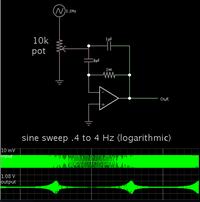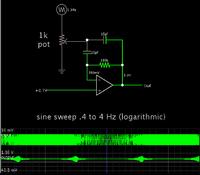patan.gova
Full Member level 3
Hello,
I am working with the Pulse(PPG) signal measurement.The circuit implemented is shown here**broken link removed** but the reference for this is taken form https://embedded-lab.com/blog/?p=5508 Some of the components in the circuit are replaced namely Phototransistor with NRJC5501RView attachment 8508.NJL5501R_E_20130418.pdf) and OPAMP with TIA OPA381(https://www.ti.com/lit/gpn/opa380), and gain here used is 1+Rf/Ri=1+680K/1.2K=567.The output of the implemented circuit is shown here

The filters are designed to allow the frequency components in the range of 0.7 to 2.3Hz as the required PPG signals are in this range.
The output seems to be nearly okay but the Noise(frequency components) indicated with the red portion is annoying.I am not sure why this is coming.
Can someone suggest changes in the circuit or if any other sort of filters are to be used so that noise can be removed resulting in a clear pulse signal which is finally needed.
Thanks in Advance.
I am working with the Pulse(PPG) signal measurement.The circuit implemented is shown here**broken link removed** but the reference for this is taken form https://embedded-lab.com/blog/?p=5508 Some of the components in the circuit are replaced namely Phototransistor with NRJC5501RView attachment 8508.NJL5501R_E_20130418.pdf) and OPAMP with TIA OPA381(https://www.ti.com/lit/gpn/opa380), and gain here used is 1+Rf/Ri=1+680K/1.2K=567.The output of the implemented circuit is shown here

The filters are designed to allow the frequency components in the range of 0.7 to 2.3Hz as the required PPG signals are in this range.
The output seems to be nearly okay but the Noise(frequency components) indicated with the red portion is annoying.I am not sure why this is coming.
Can someone suggest changes in the circuit or if any other sort of filters are to be used so that noise can be removed resulting in a clear pulse signal which is finally needed.
Thanks in Advance.
Last edited:

